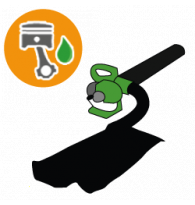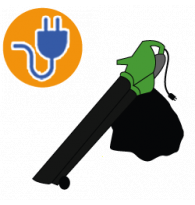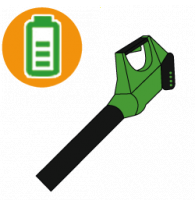What is a leaf blower vacuum, how does it work, and what is it used for?
Leaf blowers are essential tools for maintaining green spaces. They use a powerful airflow to move leaves, cut grass, and other debris, significantly simplifying cleaning operations. Some models also offer suction and shredding functionality, reducing the volume of collected materials and facilitating disposal or composting.
Generally, these devices are equipped with a petrol or electric engine that serves to produce the airflow to blow and/or vacuum leaves or other debris. Additionally, the engine can also be used to shred these residues once vacuumed, reducing the volume of the aspirated materials and making disposal or composting easier. In this case, the residues are collected in a special basket connected to the machine.
Blowers and vacuums are ideal for removing leaves from lawns, gardens, and driveways. The blowing function allows leaves to be gathered in one place, making collection easier. Besides leaves, these devices can be used to move cut grass, small branches, and other light debris, keeping the area clean and tidy.
Thanks to their versatility and power, leaf blowers are indispensable tools for both hobbyists and professional green maintenance workers.
Advantages of leaf blowers
Garden blowers and leaf vacuums offer numerous advantages over other traditional cleaning methods. We have summarized the main ones below.
- Cleaning speed: Thanks to the powerful blowing and suction capability, these devices allow cleaning operations to be completed much faster than manual collection.
- Blowing and suction: The dual function of blowing and suction allows the same tool to be used for different operations, offering greater versatility compared to tools that perform only one function.
- Waste volume reduction: Models equipped with a shredding function reduce the volume of aspirated leaves and debris, facilitating disposal and composting.
- Management of large spaces: Petrol blower vacuums, thanks to their power and autonomy, are particularly suitable for cleaning large areas such as parks and extensive gardens.
- Variety of power sources: The ability to choose between petrol, electric, and battery models allows finding the most suitable solution for one's needs, whether for small gardens or large areas.
- Year-round use: These tools are not only useful in autumn for leaf removal but also throughout the year for general green space cleaning and organic waste management.
- Ergonomic design: Many models are designed to be easily maneuverable and comfortable to use, reducing fatigue during prolonged operations.
- Portability: Battery models and backpack models offer great portability, making it easier to work on extensive or uneven terrain.
- Immediate start: Electric blowers ensure quick and hassle-free start-up, avoiding issues related to starting petrol engines.
Types of leaf blower vacuums
Leaf blower vacuums are available in three main types, each offering specific advantages and features that make it suitable for different needs and usage contexts. Knowing the peculiarities of each type is essential to make the right choice and optimize the cleaning work of green spaces.
Petrol blower vacuum
Petrol blowers and vacuums are equipped with internal combustion engines that can be 2-stroke or 4-stroke. 2-stroke engines use a mixture of oil and petrol, while 4-stroke engines run on pure petrol. These models are particularly powerful and suitable for intensive cleaning operations on large surfaces such as parks, public gardens, and sports fields. Their autonomy is not limited by the length of an electric cable, making them ideal for extensive spaces without access to power outlets.
- Power and autonomy: Thanks to combustion engines, these blowers can operate for long periods without interruptions, easily handling heavy and wet debris.
- Versatility: Some models offer the possibility to quickly switch from blower to vacuum mode and often include a shredding function to reduce the volume of aspirated leaves.
- Maintenance: Regular maintenance is required to ensure optimal performance, including cleaning air filters and periodic replacement of oil and spark plugs.
Electric blower vacuum 230V
Electric blower vacuums 230V are powered through a standard household power outlet, offering quick start-up and quieter operation compared to petrol models. They are ideal for users who have easy access to electrical outlets and need a powerful yet simple-to-use tool.
- Ease of use: They do not require fuel management, making them easier to use and maintain. The start is immediate via a simple switch.
- Constant power: The electrical connection ensures constant power without drops, allowing continuous and efficient work.
- Limitations: They are more suitable for medium-sized areas and may be limited by the length of the electric cable. The use of extensions can extend the range, but they are still not ideal for very large spaces or areas far from electricity sources.
Battery blower vacuum
Battery blower vacuums are the ideal choice for those seeking maximum freedom of movement and ease of use. Powered by rechargeable batteries, generally lithium-ion, these models are lightweight and manageable, perfect for work in domestic gardens or small green spaces.
- Portability: The total absence of cables allows free movement in any area, making them ideal for cleaning gardens with many obstacles such as trees and shrubs.
- Ease of use: They are easy to start and use, with intuitive controls and a reduced weight that reduces operator fatigue.
- Battery life: The operating duration depends on the battery capacity. Modern lithium batteries offer good autonomy and relatively short charging times, but they can still limit use for prolonged periods without breaks for recharging.
Technical features of leaf blower vacuums
When choosing a leaf blower, it is essential to consider the various technical features that affect the device's performance and ease of use. Below are the main technical features that these tools share.
Power supply
The type of power supply for blowers and vacuums is a determining factor in the choice. There are three main types of power supply:
- Petrol engine: Uses an internal combustion engine. 2-stroke engines require a mixture of oil and petrol, while 4-stroke engines run on pure petrol. These engines offer high power and are ideal for intensive work on large surfaces. However, they require regular maintenance.
- Electric: Powered through a common power outlet, the electric motor ensures immediate start-up and quiet operation. It is ideal for medium-sized areas and for those who prefer to avoid fuel management.
- Battery: Powered by rechargeable batteries, this type of motor offers great freedom of movement. Modern lithium batteries ensure good autonomy and reduced charging times, making these models perfect for small gardens and residential areas.
Displacement (for petrol blower vacuum engines)
Displacement, expressed in cubic centimeters (cc), indicates the total volume of a motor's cylinder. Generally, a larger displacement is proportional to the engine's power. In petrol garden blowers, displacement usually ranges from 26 cc to 100 cc.
- Cylinder volume: A larger cylinder can contain a greater amount of air-fuel mixture, generating higher power.
- Power delivery: Even with the same displacement, the power delivered can vary depending on the engine's structure and the quality of its components.
Power (for petrol blower and vacuum engines)
Power, measured in horsepower (Hp), indicates the engine's ability to perform work. In leaf blowers and vacuums, power ranges from 1.0 to 5.0 Hp.
- Performance: Higher power allows for moving or vacuuming heavier debris and covering larger areas in less time.
- Cost: Generally, more powerful machines are also more expensive, but they offer superior performance and greater efficiency.
Voltage (V), only for electric or battery blowers
Voltage, measured in volts (V), indicates the electrical tension of electric or battery blower vacuums. In battery models, voltage ranges from 18 to 82 V.
- Power output: Higher voltage generally corresponds to higher power and superior performance.
- Autonomy: In battery models, voltage also affects operational autonomy, with higher voltage batteries offering longer duration.
Blower functionalities
The functionalities offered by leaf blower vacuums are another crucial aspect to consider:
- Blowing: Allows moving leaves and debris through a powerful airflow.
- Blowing and suction: Some models combine the functions of leaf blower and vacuum, allowing blowing and vacuuming of leaves.
- Suction and shredding: More advanced models include a shredding function that reduces the volume of aspirated materials, facilitating disposal.
Portability
The device's portability affects ease of use and comfort during operation:
- Handheld blower vacuums: Lightweight and compact models, easy to handle and ideal for small gardens.
- Backpack blowers: Equipped with straps to be worn like a backpack, they better distribute weight and reduce fatigue.
- Backpack: The engine is mounted on a backpack, offering maximum mobility and comfort for prolonged work on large surfaces.
Collection bag capacity
Collection bag capacity, expressed in liters (l), indicates the maximum volume of leaves and debris the device can contain. It usually ranges from 35 to 72 l.
- Collection capacity: A larger capacity allows for longer work without needing to empty the bag.
- Influence on weight: A larger bag can increase the overall weight of the device when full, affecting maneuverability.
Equipment
The equipment included with blower vacuums can vary:
- Batteries and chargers: Not all battery models are sold with batteries and chargers included. It is important to check what is included in the purchase to avoid surprises.
- Accessories: Some models include additional accessories such as nozzles of different shapes and sizes to suit various cleaning needs.
Using leaf blower vacuums
Leaf blower vacuums are useful tools for both hobbyists and professional green workers.
Leaf blower vacuum for home gardens
For domestic or hobby users, leaf blower vacuums are a valuable ally in garden maintenance. These tools facilitate the cleaning of lawns, flower beds, and driveways, making the work less tiring and faster than manual collection. The most suitable models for hobby use are generally electric or battery-powered for the following reasons:
- Electric blowers – Leaf vacuums: Perfect for medium-sized gardens, these devices offer immediate start-up and quiet operation. The connection to a household power outlet ensures constant power without drops, allowing efficient work without worrying about fuel duration.
- Battery vacuum: Ideal for small gardens and residential areas, these models offer great freedom of movement thanks to the absence of cables. Rechargeable lithium-ion batteries ensure sufficient autonomy for light work, making these blowers easy to handle and use.
Professional petrol blower
Professional leaf blowers and vacuums must ensure high performance and resistance to intensive use. Petrol models are often the preferred choice for professionals in the sector such as gardeners, park maintenance workers, and large green area cleaners. The main reasons are:
- Superior power: Petrol engines, especially those with larger displacement 2-stroke or 4-stroke, offer high power, ideal for removing heavy and wet leaves and debris.
- Extended autonomy: The use of fuel allows working for extended periods without the need to stop for battery recharging or finding power outlets.
- Versatility and robustness: These models are designed to withstand intensive use and the most difficult conditions, such as cleaning parks, public gardens, and sports fields.
The main activities carried out by professionals with leaf blower vacuums include:
- Maintenance of large green areas: Cleaning parks, public gardens, camping areas, and sports fields, where high power and extended autonomy are necessary.
- Removal of heavy debris: Blowing and vacuuming wet leaves, branches, and other heavy debris that require more power.
- Long-duration work: The ability to work continuously for hours is essential to complete maintenance operations on extensive surfaces without frequent interruptions.
Buying guide for the best garden leaf blowers and vacuums
Buying the right garden blower can make a difference in terms of efficiency and satisfaction in use. Different needs require specific features, and knowing these details helps choose the most suitable model. Here is a guide to identifying the main needs and the technical features that the products to be purchased should have.
- Cleaning large surfaces: A powerful device with great autonomy is essential. Petrol blower vacuums are ideal for these contexts, especially those with 2-stroke or 4-stroke engines. Models with a power of at least 3.0 Hp and a displacement greater than 50 cc are perfect for ensuring high performance on large green areas.
- Short-duration work in medium areas: Ideal for domestic gardens of medium size. In these cases, 230V electric blowers are the best choice, as they offer good power without the need to manage fuels. Models with a power of 1.5 - 2.5 Hp and the function of suction and shredding can perform the work efficiently and without complications.
- Cleaning small gardens and residential areas: For those seeking maximum portability and ease of use, battery blower vacuums are ideal. These models with 36V or more batteries offer good autonomy and are lightweight and easy to handle. The handheld function adds further convenience, allowing agile work even in tight spaces.
- Removal of heavy and wet debris: Requires high power and robustness. In these cases, it is advisable to opt for blower vacuums with power greater than 4.0 Hp. Models with suction and shredding capacity and a displacement of 70 cc or more are particularly effective in handling heavy and wet materials.
- Precision and detail work: For cleaning around delicate plants or in hard-to-reach corners, battery blower vacuums offer greater control and maneuverability. Models with 18-24V batteries are sufficient, and the ability to adjust the airspeed allows adapting the power to different precision needs.
At this point, we also consider these additional considerations appropriate:
- Collection bag capacity: The choice of capacity depends on the amount of debris to be collected. A larger bag reduces the frequency of emptying but can make the device heavier.
- Maintenance and accessories: Check the availability of spare parts and accessories such as additional batteries and fast chargers. Ensure that the chosen blower and vacuum model is easy to maintain and that components are easily obtainable.
- Ergonomics and comfort: Consider models with ergonomic design and accessories such as shoulder straps to reduce fatigue during prolonged use.
The best brands of leaf blower vacuums
AgriEuro.com offers several renowned brands that provide a wide range of models suitable for both domestic and professional use. Here is an overview of the best brands of leaf blower vacuums available.
- Stiga Leaf Blower Vacuums: Stiga is a brand known for producing high-quality gardening equipment. Stiga blower vacuums are appreciated for their robustness, reliability, and high performance. They offer petrol, electric, and battery models suitable for various cleaning needs.
- Ryobi Leaf Blower Vacuum: Ryobi is a global leader in producing electric and battery-powered gardening tools. Ryobi blower vacuums are known for technological innovation, power, and durability. They are particularly appreciated for their battery models, which offer great freedom of movement and ease of use.
- Karcher Leaf Blower and Vacuum: Karcher is a reference brand for cleaning equipment. Karcher blower vacuums combine power and precision, making them ideal for both domestic and professional use. Their models are designed to be ergonomic and easy to use, ensuring excellent results in every situation.
- Echo Leaf Blower Vacuum: Echo is synonymous with quality and performance in the gardening equipment sector. Echo leaf blower vacuums are particularly robust and powerful, ideal for professionals who need reliable and durable equipment. They offer a range of petrol and battery models suitable for different types of work.
- Hyundai Professional Blowers and Vacuums: Hyundai offers a wide range of gardening equipment, including blowers and vacuums. Hyundai products are known for their build quality, reliability, and high performance. Available in various types, Hyundai blower vacuums meet the needs of both domestic users and professionals.
- Greenworks Garden Blowers: Greenworks specializes in battery-powered gardening equipment, offering eco-friendly and powerful solutions. Greenworks blower vacuums are known for their durability, efficiency, and ease of use. They are particularly suitable for those seeking a sustainable alternative to petrol models.
Why buy blowers on AgriEuro?
Buying a leaf blower vacuum on AgriEuro.com offers numerous advantages.
- Fast and free shipping: Shipping is managed by AgriEuro's logistics centers, ensuring quick deliveries without additional costs.
- Spare parts always available: It is possible to order spare parts directly from the site, ensuring long-lasting use and the ability to keep the device in perfect condition.
- Attentive and personalized after-sales assistance: AgriEuro's support team is always available to solve any problem and provide advice on the use and maintenance of products.
These reasons make AgriEuro.com the ideal site for purchasing leaf blower vacuums, guaranteeing quality, convenience, and excellent customer service. Visit our site to discover current offers and find the model best suited to your needs.
FAQ on leaf blower vacuums
1. What is a blower used for?
The leaf blower is an essential tool for garden maintenance. It is mainly used to remove leaves, cut grass, and other debris from surfaces such as lawns, driveways, and courtyards. It eliminates debris quickly and efficiently, making cleaning easier compared to manual methods. It is particularly useful during autumn when leaves fall abundantly.
Some advanced models also function as leaf vacuums, collecting and shredding leaves for easy disposal or composting. Blowers are available in electric, battery, and petrol versions, each with specific advantages depending on the user's needs.
2. How to choose a leaf blower vacuum?
Choosing a leaf blower depends on various factors. Here are the main considerations for the choice:
- Type of power supply: Battery blowers are lightweight and quiet but have limited duration. Electric models offer continuous power but require a power cable. Petrol blowers are powerful and suitable for large areas but are noisier and require maintenance.
- Power: Measured in CFM (cubic feet per minute) and MPH (miles per hour). A blower with high CFM and MPH removes more debris faster.
- Weight and maneuverability: A lightweight blower is easier to use for extended periods but may be less powerful.
- Additional functionalities: Models that combine blowing and vacuuming can be more versatile, allowing for leaf collection and shredding.
3. What are the characteristics of a good blower?
A good blower must have specific characteristics that guarantee efficiency and ease of use.
- Power: A good blower must have sufficient power to effectively manage debris removal. Measured in CFM and MPH, the higher the value, the better the performance.
- Ergonomics: It must be comfortable to use, with ergonomic handles and a balanced design to reduce user fatigue.
- Ease of use: It must be easy to start and maneuver, with intuitive controls and manageable weight.
- Noise level: A quiet blower is preferable, especially in residential areas where noise can be an issue.
- Battery life (for battery models): It must have sufficient duration to complete the work without frequent interruptions for recharging.
4. How much does a leaf vacuum cost?
The cost of a leaf blower varies widely based on the type, brand, and specific features of the model.
- Electric models: These blowers are generally the cheapest, with prices starting at around 50 euros for basic models and can go up to 150 euros for more powerful and advanced models.
- Battery models: The price of battery blowers ranges from about 40 euros for basic models up to 2000 euros for high-end ones, with long-lasting batteries and high power backpack models.
- Petrol models: These are the most expensive, with prices ranging from 100 euros for basic models to over 800 euros for professional models with high performance.
Besides the initial price, consider maintenance costs and any necessary accessories such as extra batteries or oils for petrol models.
5. How does a blower vacuum work?
A blower vacuum combines the functionalities of a blower and a leaf vacuum in a single tool.
- Blower mode: In this mode, the device uses an engine to generate a powerful airflow that blows leaves and debris off the ground. The speed and power of the airflow are adjustable to suit different needs.
- Vacuum mode: By reversing the function, the blower vacuum can suck up leaves and debris, which are conveyed into a collection bag. Some models are equipped with a shredding function that reduces the volume of aspirated debris, facilitating disposal or composting.
6. How does a leaf vacuum work?
A leaf vacuum is specifically designed to collect leaves and small debris from the ground. It works by creating a powerful airflow that sucks up debris, conveying it into a collection bag.
- Suction: The device uses an engine to create suction that draws leaves and debris from the ground. The air is filtered to separate the debris, which is then collected in a bag or container.
- Filtration: Many vacuums are equipped with a filtration system that prevents the aspirated material from clogging the engine, ensuring efficient operation.
- Collection: The debris is collected in a collection bag that can be easily emptied once full. Some models offer a shredding function that reduces the volume of debris, making their disposal easier.
7. Blower or vacuum: which to choose?
The choice between a blower and a vacuum depends on the specific garden cleaning needs and personal preferences. Below are some main considerations for the choice:
- Type of debris: If the garden is mainly covered with leaves, a vacuum might be more useful for collecting them directly. If there are also other types of debris, such as cut grass or small branches, a blower might be more versatile.
- Functionality: If greater versatility is desired, a combined blower-vacuum model is the best choice, allowing for blowing away debris and then collecting it.
We have also listed the advantages of the blower:
- Speed and power: Excellent for quickly removing large amounts of leaves and debris.
- Ease of use: Often lighter and more manageable than vacuums.
And the advantages of the vacuum:
- Complete cleaning: Collects and gathers debris, reducing the need for manual collection.
- Volume reduction: Models with a shredding function reduce the volume of aspirated debris.
8. How to use a leaf blower vacuum?
Using a leaf blower vacuum is simple, but it is important to follow some guidelines to achieve the best results and ensure safety.
- Preparation: Wear protective gear such as goggles and earplugs. Ensure the area to be cleaned is free of objects that could be damaged or cause damage.
- Blower mode: Start the device and select the blower mode. Use the airflow to move leaves and debris to a specific area.
- Vacuum mode: Once the leaves are piled up, switch to vacuum mode. Vacuum the leaves and debris, which will be conveyed into the collection bag.
- Emptying the bag: When the collection bag is full, turn off the device and empty the bag into a composting area or a trash bag.
- Maintenance: After use, clean the blower vacuum and check for any debris blocked inside. Regular maintenance ensures efficient operation and a long device lifespan.
Here are also some tips that can certainly be useful:
- Adjust the power: Use the appropriate power for the type of debris and the surface to be cleaned.
- Avoid wet surfaces: Wet leaves can clog the vacuum, so it's best to use it on dry surfaces.
9. How much does a leaf blower weigh?
The weight of a leaf blower varies depending on the type and specifications of the model. Blowers can be divided into three main categories: electric, battery, and petrol, each with different average weights.
- Electric blowers: These are generally the lightest, weighing between 2 and 4 kg. They are easy to handle and ideal for light and medium work in small and medium-sized gardens.
- Battery blowers: These models usually weigh between 3 and 5 kg, depending on the battery capacity. They are more versatile than electric models as they do not require a power cable.
- Petrol blowers: These are generally the heaviest, weighing between 5 and 10 kg. They are more powerful and suitable for heavy work in large gardens or professional areas.
10. How powerful is a leaf blower?
The power of a leaf blower is measured in two main units: CFM (cubic feet per minute) and MPH (miles per hour). These measures indicate respectively the volume of air moved and the speed of the air emitted by the blower.
Below we have listed the typical power values:
- Electric blowers: Generally have a power between 200 and 400 CFM and an airspeed between 100 and 200 MPH. They are ideal for light and medium work.
- Battery blowers: These models offer power similar to that of electric models, with values ranging from 200 to 500 CFM and speeds between 100 and 150 MPH.
- Petrol blowers: They are the most powerful, with power that can reach 600 CFM and airspeed up to 200 MPH. They are suitable for heavy work and cleaning large areas.
11. How long does a blower battery last?
The duration of a blower battery depends on the battery's capacity and the level of use. Batteries are measured in ampere-hours (Ah), and a higher Ah capacity generally offers a longer duration.
- Small capacity batteries (2-4 Ah): Generally last between 20 and 40 minutes of continuous use. They are suitable for small gardens and light work.
- Medium capacity batteries (5-7 Ah): Offer a duration of 40-60 minutes. They are ideal for medium-sized gardens and moderate work.
- Large capacity batteries (8-12 Ah): Can last from 60 minutes to over 90 minutes. They are perfect for heavy work and large gardens.
12. Why won't the blower start?
If the blower won't start, the causes can vary depending on the type of blower (electric, battery, or petrol). Identifying the cause of the problem can help resolve it quickly and resume work.
Possible causes for an electric blower:
- Power supply: Check that the power cable is properly connected and that the power outlet is working. Check for any safety switches or blown fuses.
- Power switch: Ensure that the power switch is in the correct position and functioning.
- Engine problems: The engine may be overheated or have internal issues. Allow the engine to cool and try restarting.
Possible causes for a battery blower:
- Dead battery: Check the battery charge level. If it is dead, fully recharge it before attempting to start again.
- Battery connections: Ensure that the battery is properly inserted and that the terminals are clean and free of corrosion.
- Battery issues: The battery may be damaged or defective. Try replacing it with a working battery.
Possible causes for a petrol blower:
- Fuel: Check that there is fuel in the tank and that it is of good quality. Old or contaminated fuel can cause problems.
- Spark plugs: The spark plugs may be dirty or defective. Cleaning or replacing the spark plugs can solve the problem.
- Air filter: A clogged air filter can prevent the engine from starting. Clean or replace the air filter.
- Ignition system: Check that the ignition system is functioning correctly. It may be necessary to replace components such as the ignition coil or electronic module.
General troubleshooting steps:
- Visual inspection: Visually check all components for any signs of damage or wear.
- Consult the manual: Refer to the user manual for specific instructions and troubleshooting advice.
- Professional assistance: If the problem persists, contact a professional service center for a thorough diagnosis and repair.










































